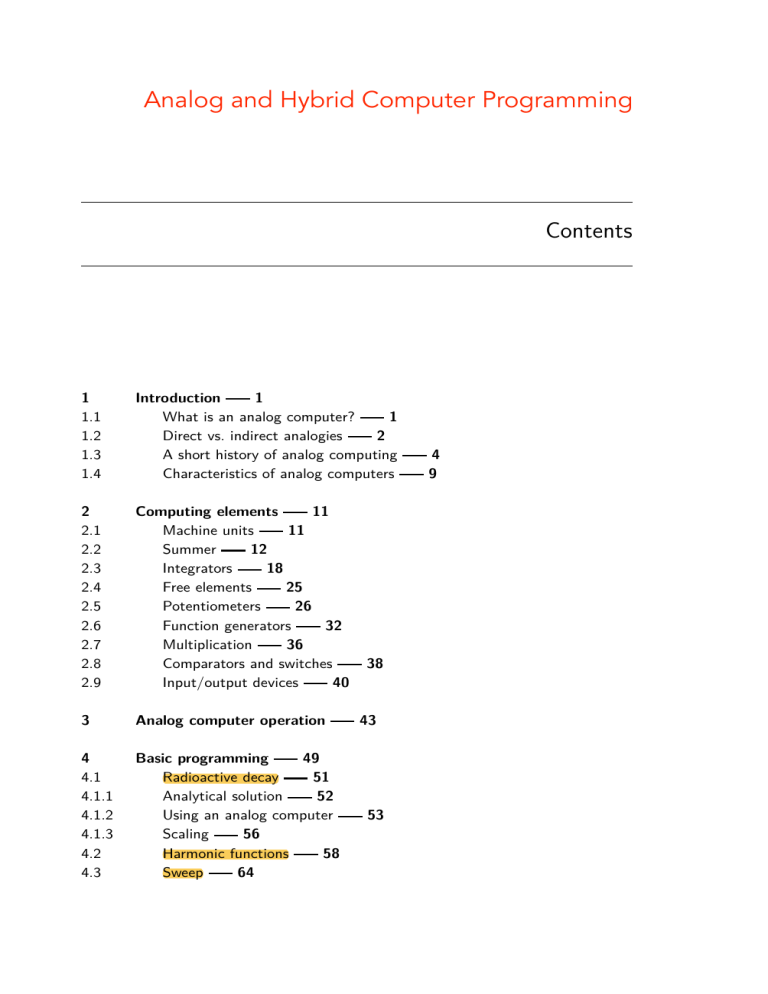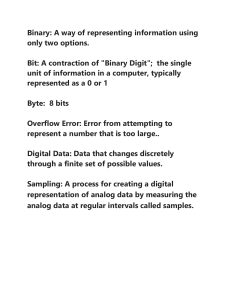Analog & Hybrid Computer Programming: Table of Contents
advertisement

Analog and Hybrid Computer Programming Contents 1 1.1 1.2 1.3 1.4 Introduction 1 What is an analog computer? 1 Direct vs. indirect analogies 2 A short history of analog computing Characteristics of analog computers 2 2.1 2.2 2.3 2.4 2.5 2.6 2.7 2.8 2.9 Computing elements 11 Machine units 11 Summer 12 Integrators 18 Free elements 25 Potentiometers 26 Function generators 32 Multiplication 36 Comparators and switches Input/output devices 40 3 Analog computer operation 43 4 4.1 4.1.1 4.1.2 4.1.3 4.2 4.3 Basic programming 49 Radioactive decay 51 Analytical solution 52 Using an analog computer Scaling 56 Harmonic functions 58 Sweep 64 53 38 4 9 4.4 4.4.1 4.4.2 4.5 4.5.1 4.5.2 4.5.3 Mathematical pendulum 65 Straightforward implementation 66 Variants 67 Mass-spring-damper system 68 Analytical solution 69 Using an analog computer 71 RLC-circuit 73 5 Special functions 77 5.1 Inverse functions 77 5.1.1 Square root 78 5.1.2 Division 79 5.2 f (t) = 1/t 80 5.3 Powers and polynomials 81 5.4 Low pass filter 82 5.5 Triangle/square wave generator 83 5.6 Ideal diode 85 5.7 Absolute value 86 5.8 Limiters 86 5.9 Dead-space 88 5.10 Hysteresis 89 5.11 Bang-bang 90 5.12 Minimum/maximum holding circuits 5.13 Sample & Hold 93 5.14 Time derivative 94 5.15 Time delay 95 5.15.1 Historic approaches to delay 97 5.15.2 Digitization 98 99 5.15.3 Sample and hold circuits 5.15.4 Analog delay networks 101 6 6.1 6.2 6.3 6.3.1 6.3.2 6.3.3 6.4 6.4.1 6.4.2 6.4.3 Examples 109 Chemical kinetics 109 Damped pendulum with external force Mathieu’s equation 116 Introduction 116 Scaling and programming 117 Results 118 119 Van der Pol’s equation Introduction 119 Programming 121 Results 123 91 114 6.5 6.6 6.7 6.8 6.9 6.10 6.11 6.12 6.13 6.14 6.15 6.16 6.17 6.18 6.19 6.20 6.21 6.22 6.23 6.24 6.25 6.26 Solving the one-dimensional Schrödinger equation Ballistic trajectory 126 Charged particle in a magnetic field 127 Rutherford-scattering 131 Celestial mechanics 132 Bouncing ball 137 Zombie apocalypse 141 Rössler attractor 143 Lorenz attractor 145 Another Lorenz attractor 147 Chua attractor 148 Nonlinear chaos 152 Aizawa attractor 153 Nosé-Hoover oscillator 155 Rotating spiral 157 Flow around an airfoil 157 Heat transfer 162 Two-dimensional heat transfer 168 Systems of linear equations 170 Human-in-the-loop 176 Inverted pendulum 179 Double pendulum 186 7 7.1 7.2 7.3 7.4 7.5 Hybrid computing 193 Hybrid controllers 194 Basic operation 196 Shell trajectory 198 Data gathering 201 Training an AI with an analog computer 8 Summary and outlook A Solving the heat equation with a passive network B B.1 B.1.1 B.1.2 B.1.3 B.1.4 B.2 B.3 221 The Laplace transform Basic functions 222 Step function 222 Delta function 223 Ramp function 223 Exponential and trigonometric functions Laplace transforms of basic operations Further characteristics 226 123 204 211 224 225 215 B.4 B.5 B.6 Inverse Laplace transform 226 Example 227 Block diagrams and transfers functions C C.1 C.2 C.3 Mikusiński’s operational calculus Introduction 231 Trigonometric functions 234 Example 235 D An oscilloscope multiplexer 237 E A log() function generator 241 F A sine/cosine generator G A simple joystick interface H The Analog Paradigm bus system I HyCon commands 249 231 243 245 247 228
